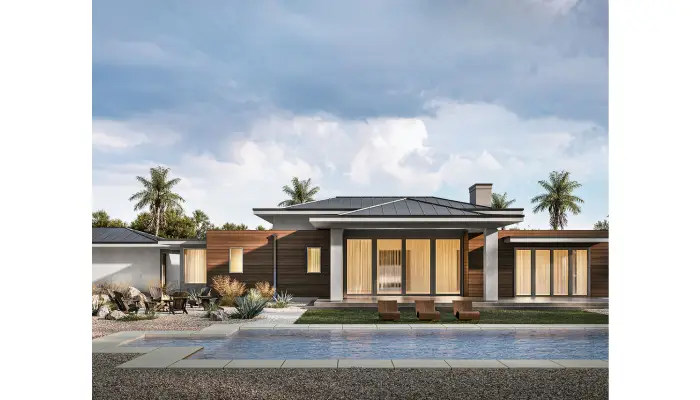Architectural visualization is a powerful tool that can really boost your project’s success. By creating detailed 3D models allows everyone involved—architects, clients, and contractors—to see the vision before construction even starts. This not only improves communication but also keeps clients engaged and informed, enabling them to provide better feedback. Plus, clear visuals can speed up approvals and even turn into eye-catching marketing materials. To get the most out of this partnership, bring in your visualization team early on and use collaborative tools for real-time input. Clear objectives and regular updates ensure everyone stays aligned throughout the process.
1. Benefits of Using an Architectural Visualization Company
Architectural visualization brings designs to life through detailed 3D models and visual representations. This process is essential for stakeholders to truly grasp the project before it begins, leading to better decisions. One of the main benefits of collaborating with an architectural visualization company is enhanced communication. It allows architects, clients, and contractors to share their ideas clearly, reducing misunderstandings. For instance, a client may envision a different layout, but with visual aids, architects can adjust the design based on specific feedback.
Moreover, improved client engagement is a significant advantage. Seeing their project in a lifelike manner instills confidence in clients, enabling them to provide more insightful feedback. This engagement can lead to faster approvals, as high-quality visuals help convey the final outcome effectively. In a competitive market, having stunning visuals can also serve as a marketing tool, drawing in potential clients or investors.
Another important benefit is the reduction of errors. Early visualization can highlight design flaws that might go unnoticed in traditional plans, allowing teams to make necessary adjustments before construction begins. This proactive approach not only saves time but also minimizes costly changes later on.
2. Understanding Architectural Visualization
Architectural visualization is the process of creating detailed 3D models and visual representations of architectural designs. This technique allows stakeholders, including architects, clients, and contractors, to visualize the project before any physical construction begins. By presenting a clear visual of what the final outcome will look like, architectural visualization plays a crucial role in facilitating better decision-making. For instance, a developer might use a 3D rendering to showcase a new residential complex, helping potential buyers grasp the layout and design before it’s built. This clarity can lead to a more cohesive understanding among all parties involved, minimizing misunderstandings and ensuring that everyone is on the same page.
3. Strategies for Integration with Visualization Teams
Engaging the architectural visualization team early in your project can set the foundation for success. By involving them from the beginning, you can ensure their insights guide design decisions, making the final outcome more aligned with your vision. For instance, if a visualization specialist points out potential issues in the layout, adjustments can be made before they turn into costly changes later on.
Utilizing collaboration tools is essential for maintaining clear communication. Platforms that allow real-time sharing of updates and visuals can bridge gaps between architects, clients, and contractors, ensuring everyone is on the same page. This can prevent misunderstandings and streamline the design process.
Regular check-ins with the visualization team help sustain momentum. Scheduling frequent meetings to discuss progress and gather input keeps the project aligned with goals. For example, a simple weekly update can highlight shifts in design preferences or technical challenges, allowing for timely adjustments. This proactive approach fosters a collaborative environment where feedback is valued and integrated.
4. Best Practices for Collaborating with Visualization Experts
To get the most out of your partnership with an architectural visualization company, start by setting clear objectives for what you hope to achieve. This could range from validating design concepts to creating engaging presentations for clients. Detailed project briefs are essential. Include specifics about design intent, materials, and the surrounding environment to give the visualization team a solid foundation.
Establishing effective feedback loops is also crucial. Create a structured process for gathering input from various stakeholders. This helps in ensuring that everyone’s perspectives are taken into account, leading to a more refined visualization. Regular check-ins can facilitate this process, allowing for adjustments based on collaborative feedback.
Lastly, consider utilizing advanced technologies such as virtual reality (VR) and augmented reality (AR). These tools can take visualizations to the next level, providing immersive experiences that can help clients understand the project in a new way. For instance, a client could walk through a VR model of their future home, making it easier for them to express their thoughts and preferences.
- Communicate clearly and frequently to establish expectations
- Share your project’s goals and vision with the visualization team
- Provide detailed feedback on drafts and prototypes
- Include visualization experts in early brainstorming sessions
- Set realistic timelines and respect the team’s deadlines
- Foster an open environment for creative ideas and suggestions
- Understand the technical limitations and capabilities of the visualization tools used
5. The Role of Technology in Architectural Visualization
Technology plays a crucial role in architectural visualization, making it possible to create stunning and realistic representations of designs. The use of advanced software allows architects to produce 3D models that closely mimic the final structure. Tools like 3D rendering software enable teams to visualize lighting, materials, and textures in great detail, helping clients grasp the project’s vision more completely.
Moreover, innovations such as virtual reality (VR) and augmented reality (AR) have transformed how stakeholders interact with designs. For instance, clients can walk through a virtual space before it’s built, experiencing the layout and ambiance firsthand. This immersive experience not only captivates clients but also fosters deeper understanding and engagement.
Additionally, cloud-based collaboration platforms facilitate real-time updates and feedback. This means that as changes are made, everyone involved can see and discuss them immediately, reducing misunderstandings and ensuring all parties are aligned. The integration of these technologies significantly enhances the overall efficiency of the design process, allowing for quicker revisions and more effective communication.
Frequently Asked Questions
1. What exactly does an architectural visualization company do?
An architectural visualization company creates detailed images or models of building projects. They help you see what a project will look like before it’s built, using 3D renderings and virtual tours.
2. How can architectural visualization help my project be successful?
Architectural visualization helps by providing a clear picture of your project. This makes it easier for everyone involved—like clients and builders—to understand the vision, which can lead to better decision-making and fewer mistakes.
3. What types of projects can benefit from architectural visualization?
Any project that involves buildings can benefit, from residential homes to commercial spaces. Even outdoor areas like parks or urban developments can be visualized to showcase their design.
4. How does the visualization process typically work?
The process usually starts with gathering your ideas and plans. Then, the company creates initial sketches or 3D models. After that, they refine the details and produce realistic images or animations for you to review.
5. Can I use architectural visualization for marketing or presentations?
Absolutely! These visuals are great for marketing. You can use them in brochures, websites, or during presentations to attract investors and clients by showing off your project in a visually appealing way.
TL;DR Architectural visualization creates 3D models that help stakeholders better understand designs before construction. Using an architectural visualization company enhances communication, client engagement, and error reduction, leading to faster approvals and marketing advantages. For effective integration, involve visualization teams early, use collaboration tools, and maintain regular updates. Best practices include setting clear objectives, providing detailed briefs, and implementing feedback loops. Embracing technology like virtual reality can elevate the visualization experience, ultimately improving project outcomes.




